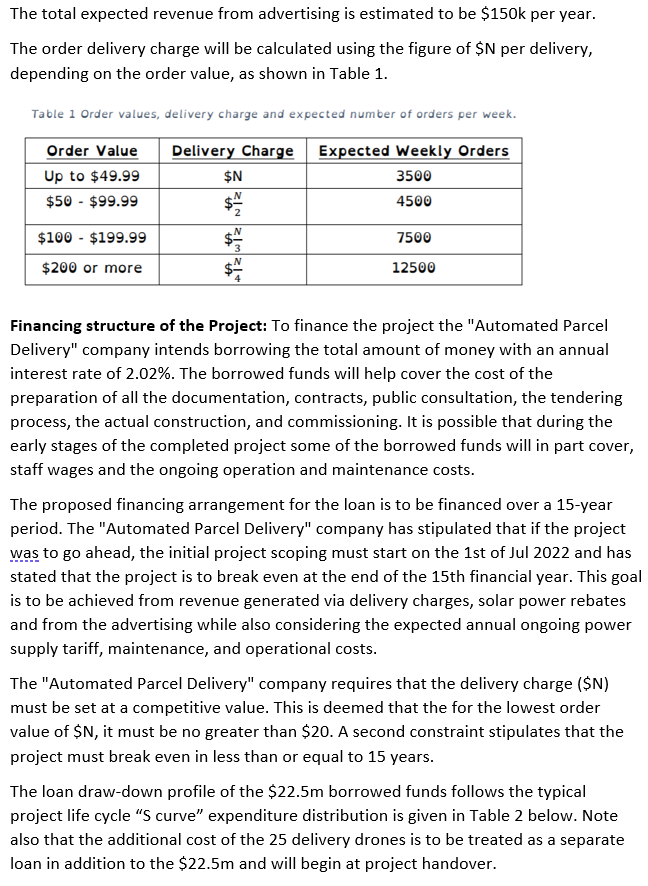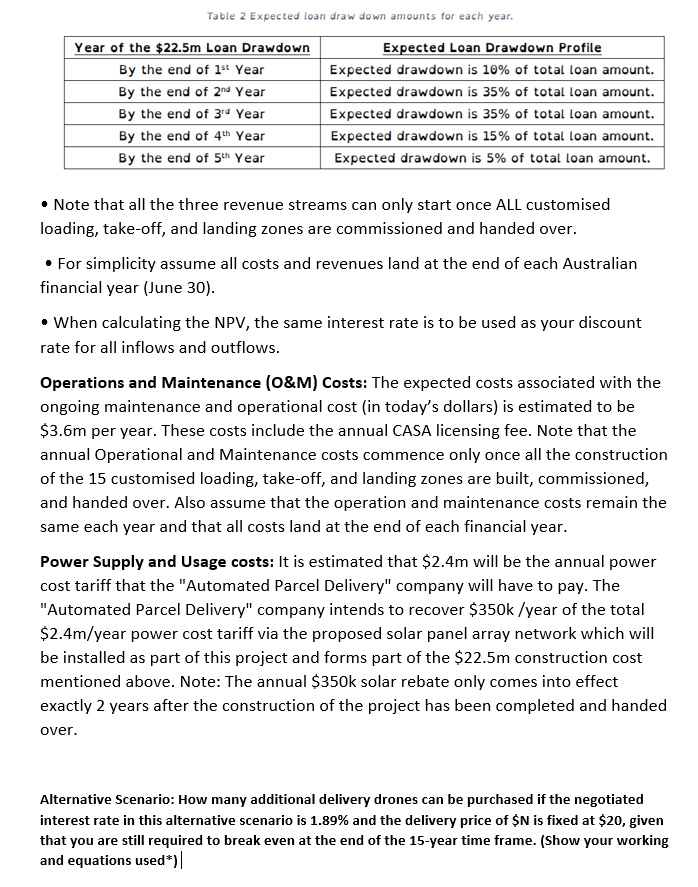


Scenario Details The "Automated Parcel Delivery" company is examining a proposal to provide a drone parcel delivery service for supermarkets across the Perth Metropolitan area. It will operate the drones from 14 supermarkets and 1 warehouse location across Perth. To do this, the 14 supermarkets and 1 warehouse need to have customised loading, take-off and landing zones built. These will be built by the "Automated Parcel Delivery" company. The company will use 25 drones spread across the 15 locations to carry out the deliveries. A network of solar panels will be installed at the 15 locations for charging the drones. This will minimise the use of the main electricity grid powering the systems. A solar rebate will be offered by the WA government to the "Automated Parcel Delivery" company to encourage the use of renewable energy. The delivery drones can carry up to 5 deliveries. The normal delivery window, using trucks, is a 2-hour timeframe. With using the drones, the delivery window will be reduced to a 15-minute window. For Western Australia, and to start with, Perth, this will be a significant infrastructure project. If the trial is successful, the "Automated Parcel Delivery" company would be looking to expand their service network to other capital cities in Australia with an outlook to expand globally. It is proposed that the delivery drones' trail would be run as a fully costed, stand- alone project and a self-sustaining business venture. The project assumes that all approvals have been given by the Civil Aviation Safety Authority (CASA) to allow the delivery drones to operate. Congratulations, the "Automated Parcel Delivery" company has employed you as an engineering consultant and assigned you the task to work with the "Automated Parcel Delivery" company planning design team on the proposed new loading, take- off, and landing zones. The total construction cost of the project is estimated to be $22.5 million in today's dollars. In addition to the construction costs, 25 new delivery drones will be purchased at a cost of $23,500 each. The drones will be purchased on the same day as the completion of construction so that they can immediately start earning revenue. Use these figures to determine the total amount you will be required to borrow to finance the project. These figures include the complete construction costs associated with the customised loading, take-off, and landing zones. Revenue will be generated via delivery fees and the solar panel rebate and from the electronic advertising to be placed at the customised loading, take-off, and landing platforms. The total expected revenue from advertising is estimated to be $150k per year. The order delivery charge will be calculated using the figure of $N per delivery, depending on the order value, as shown in Table 1. Table 1 Order values, delivery charge and expected number of orders per week. Order Value Up to $49.99 $50 - $99.99 Delivery Charge Expected Weekly Orders 3500 $ 4500 $N 7500 $100 - $199.99 $200 or more $ 12500 Financing structure of the Project: To finance the project the "Automated Parcel Delivery" company intends borrowing the total amount of money with an annual interest rate of 2.02%. The borrowed funds will help cover the cost of the preparation of all the documentation, contracts, public consultation, the tendering process, the actual construction, and commissioning. It is possible that during the early stages of the completed project some of the borrowed funds will in part cover, staff wages and the ongoing operation and maintenance costs. The proposed financing arrangement for the loan is to be financed over a 15-year period. The "Automated Parcel Delivery" company has stipulated that if the project was to go ahead, the initial project scoping must start on the 1st of Jul 2022 and has stated that the project is to break even at the end of the 15th financial year. This goal is to be achieved from revenue generated via delivery charges, solar power rebates and from the advertising while also considering the expected annual ongoing power supply tariff, maintenance, and operational costs. The "Automated Parcel Delivery" company requires that the delivery charge ($N) must be set at a competitive value. This is deemed that the for the lowest order value of $N, it must be no greater than $20. A second constraint stipulates that the project must break even in less than or equal to 15 years. The loan draw-down profile of the $22.5m borrowed funds follows the typical project life cycle S curve expenditure distribution is given in Table 2 below. Note also that the additional cost of the 25 delivery drones is to be treated as a separate loan in addition to the $22.5m and will begin at project handover. Table 2 Expected loan draw down amounts for each year. Year of the $22.5m Loan Drawdown Expected Loan Drawdown Profile By the end of 1st Year Expected drawdown is 10% of total loan amount. By the end of 2nd Year Expected drawdown is 35% of total loan amount. By the end of 3rd Year Expected drawdown is 35% of total loan amount. By the end of 4th Year Expected drawdown is 15% of total loan amount. By the end of 5th Year Expected drawdown is 5% of total loan amount. Note that all the three revenue streams can only start once ALL customised loading, take-off, and landing zones are commissioned and handed over. For simplicity assume all costs and revenues land at the end of each Australian financial year (June 30). When calculating the NPV, the same interest rate is to be used as your discount rate for all inflows and outflows. Operations and Maintenance (O&M) Costs: The expected costs associated with the ongoing maintenance and operational cost (in today's dollars) is estimated to be $3.6m per year. These costs include the annual CASA licensing fee. Note that the annual Operational and Maintenance costs commence only once all the construction of the 15 customised loading, take-off, and landing zones are built, commissioned, and handed over. Also assume that the operation and maintenance costs remain the same each year and that all costs land at the end of each financial year. Power Supply and Usage costs: It is estimated that $2.4m will be the annual power cost tariff that the "Automated Parcel Delivery" company will have to pay. The "Automated Parcel Delivery" company intends to recover $350k/year of the total $2.4m/year power cost tariff via the proposed solar panel array network which will be installed as part of this project and forms part of the $22.5m construction cost mentioned above. Note: The annual $350k solar rebate only comes into effect exactly 2 years after the construction of the project has been completed and handed over. Alternative Scenario: How many additional delivery drones can be purchased if the negotiated interest rate in this alternative scenario is 1.89% and the delivery price of $N is fixed at $20, given that you are still required to break even at the end of the 15-year time frame. (Show your working and equations used*)| Scenario Details The "Automated Parcel Delivery" company is examining a proposal to provide a drone parcel delivery service for supermarkets across the Perth Metropolitan area. It will operate the drones from 14 supermarkets and 1 warehouse location across Perth. To do this, the 14 supermarkets and 1 warehouse need to have customised loading, take-off and landing zones built. These will be built by the "Automated Parcel Delivery" company. The company will use 25 drones spread across the 15 locations to carry out the deliveries. A network of solar panels will be installed at the 15 locations for charging the drones. This will minimise the use of the main electricity grid powering the systems. A solar rebate will be offered by the WA government to the "Automated Parcel Delivery" company to encourage the use of renewable energy. The delivery drones can carry up to 5 deliveries. The normal delivery window, using trucks, is a 2-hour timeframe. With using the drones, the delivery window will be reduced to a 15-minute window. For Western Australia, and to start with, Perth, this will be a significant infrastructure project. If the trial is successful, the "Automated Parcel Delivery" company would be looking to expand their service network to other capital cities in Australia with an outlook to expand globally. It is proposed that the delivery drones' trail would be run as a fully costed, stand- alone project and a self-sustaining business venture. The project assumes that all approvals have been given by the Civil Aviation Safety Authority (CASA) to allow the delivery drones to operate. Congratulations, the "Automated Parcel Delivery" company has employed you as an engineering consultant and assigned you the task to work with the "Automated Parcel Delivery" company planning design team on the proposed new loading, take- off, and landing zones. The total construction cost of the project is estimated to be $22.5 million in today's dollars. In addition to the construction costs, 25 new delivery drones will be purchased at a cost of $23,500 each. The drones will be purchased on the same day as the completion of construction so that they can immediately start earning revenue. Use these figures to determine the total amount you will be required to borrow to finance the project. These figures include the complete construction costs associated with the customised loading, take-off, and landing zones. Revenue will be generated via delivery fees and the solar panel rebate and from the electronic advertising to be placed at the customised loading, take-off, and landing platforms. The total expected revenue from advertising is estimated to be $150k per year. The order delivery charge will be calculated using the figure of $N per delivery, depending on the order value, as shown in Table 1. Table 1 Order values, delivery charge and expected number of orders per week. Order Value Up to $49.99 $50 - $99.99 Delivery Charge Expected Weekly Orders 3500 $ 4500 $N 7500 $100 - $199.99 $200 or more $ 12500 Financing structure of the Project: To finance the project the "Automated Parcel Delivery" company intends borrowing the total amount of money with an annual interest rate of 2.02%. The borrowed funds will help cover the cost of the preparation of all the documentation, contracts, public consultation, the tendering process, the actual construction, and commissioning. It is possible that during the early stages of the completed project some of the borrowed funds will in part cover, staff wages and the ongoing operation and maintenance costs. The proposed financing arrangement for the loan is to be financed over a 15-year period. The "Automated Parcel Delivery" company has stipulated that if the project was to go ahead, the initial project scoping must start on the 1st of Jul 2022 and has stated that the project is to break even at the end of the 15th financial year. This goal is to be achieved from revenue generated via delivery charges, solar power rebates and from the advertising while also considering the expected annual ongoing power supply tariff, maintenance, and operational costs. The "Automated Parcel Delivery" company requires that the delivery charge ($N) must be set at a competitive value. This is deemed that the for the lowest order value of $N, it must be no greater than $20. A second constraint stipulates that the project must break even in less than or equal to 15 years. The loan draw-down profile of the $22.5m borrowed funds follows the typical project life cycle S curve expenditure distribution is given in Table 2 below. Note also that the additional cost of the 25 delivery drones is to be treated as a separate loan in addition to the $22.5m and will begin at project handover. Table 2 Expected loan draw down amounts for each year. Year of the $22.5m Loan Drawdown Expected Loan Drawdown Profile By the end of 1st Year Expected drawdown is 10% of total loan amount. By the end of 2nd Year Expected drawdown is 35% of total loan amount. By the end of 3rd Year Expected drawdown is 35% of total loan amount. By the end of 4th Year Expected drawdown is 15% of total loan amount. By the end of 5th Year Expected drawdown is 5% of total loan amount. Note that all the three revenue streams can only start once ALL customised loading, take-off, and landing zones are commissioned and handed over. For simplicity assume all costs and revenues land at the end of each Australian financial year (June 30). When calculating the NPV, the same interest rate is to be used as your discount rate for all inflows and outflows. Operations and Maintenance (O&M) Costs: The expected costs associated with the ongoing maintenance and operational cost (in today's dollars) is estimated to be $3.6m per year. These costs include the annual CASA licensing fee. Note that the annual Operational and Maintenance costs commence only once all the construction of the 15 customised loading, take-off, and landing zones are built, commissioned, and handed over. Also assume that the operation and maintenance costs remain the same each year and that all costs land at the end of each financial year. Power Supply and Usage costs: It is estimated that $2.4m will be the annual power cost tariff that the "Automated Parcel Delivery" company will have to pay. The "Automated Parcel Delivery" company intends to recover $350k/year of the total $2.4m/year power cost tariff via the proposed solar panel array network which will be installed as part of this project and forms part of the $22.5m construction cost mentioned above. Note: The annual $350k solar rebate only comes into effect exactly 2 years after the construction of the project has been completed and handed over. Alternative Scenario: How many additional delivery drones can be purchased if the negotiated interest rate in this alternative scenario is 1.89% and the delivery price of $N is fixed at $20, given that you are still required to break even at the end of the 15-year time frame. (Show your working and equations used*)|









